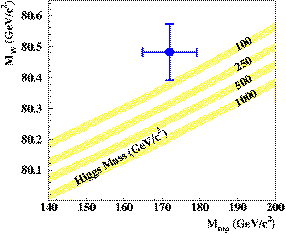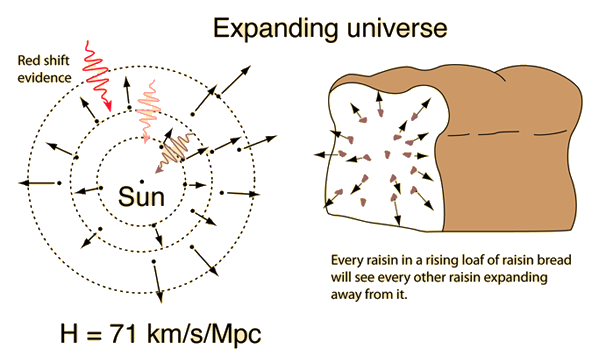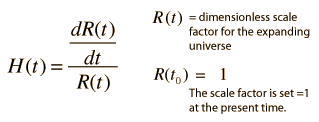O Bosão de Higgs (Informação do CERN)
Prémios Nobel - (2) Peter Higgs e o belga François Englert
BósonPB ou BosãoPE de Higgs é uma partícula elementar bosônica prevista pelo Modelo Padrão de partículas, teoricamente surgida logo após ao Big Bang de escala maciça hipotética predita para validar o modelo padrão atual de partículas2 e provisoriamente confirmada em 14 de março de 2013.3 Representa a chave para explicar a origem da massa das outras partículas elementares. Todas as partículas conhecidas e previstas são divididas em duas classes: férmions (partículas com spin da metade de um número ímpar) e bósons (partículas com spin inteiro).
A compreensão dos fenômenos físicos que faz com que certas partículas elementares possuam massa e que haja diferença entre as forças eletromagnética (cuja interação é realizada pelos fótons) e a força fraca (cuja interação é feita pelos bósons W e Z) são críticas em muitos aspectos da estrutura da matéria microscópica e macroscópica; assim se existir, o bóson de Higgs terá um efeito enorme na compreensão do mundo em torno de nós.
O bóson de Higgs foi predito primeiramente em 1964 pelo físico britânico Peter Higgs, trabalhando as ideias de Philip Anderson. Entretanto, desde então não houve condições tecnológicas de buscar a possível existência do bóson até o funcionamento do Grande Colisor de Hádrons (LHC) meados de 2008. A faixa energética de procura do bóson foi se estreitando e, em dezembro de 2011, limites energéticos se encontram entre as faixas de 116-130 GeV, segundo a equipe ATLAS, e entre 115 e 127 GeV de acordo com o CMS.
Em 4 de julho de 2012, anunciou-se que uma partícula desconhecida e com massa entre 125 e 127 GeV/c2 foi detectada; físicos suspeitaram na época que se tratava do bóson de Higgs. Em março de 2013, provou-se que a partícula se comportava, interagia e decaía de acordo com as várias formas preditas pelo Modelo Padrão, além de provisoriamente provar-se que ela possuía paridade positiva e spin nulo, dois atributos fundamentais de um bóson de Higgs, indicando fortemente a existência da partícula.
Fora da comunidade científica, é mais conhecida como a partícula de Deus (do original God particle ) devido ao fato desta partícula permitir que as demais possuam diferentes massas - contudo, a tradução literária do inglês seria "a partícula-Deus". Segundo o físico brasileiro Marcelo Gleiser, o título surgiu com o livro do também físico Leon Lederman, que propôs à editora o título Goddamn particle (Partícula maldita), que não tem qualquer vinculação com Deus, e serviria para demonstrar sua frustração em não ter encontrado o bóson de Higgs. Porém Lederman foi convencido a aceitar a mudança por razões comerciais.9
Em julho de 2012, as colaborações ATLAS e CMS anunciaram que tinham descoberto uma nova partícula com uma massa de cerca de 125 GeV. Neste momento, utilizou-se o termo "Higgs tipo" para descrever a partícula cujas propriedades permanecem a ser estudado. Graças ao excelente desempenho do LHC, temos a máquina no segundo semestre de 2012, quatro vezes mais dados para 8 TeV que o volume utilizado na análise que levou à descoberta. Armado com estes dados, os experimentos foram presentes novos resulta em março de 2013, e as evidências disponíveis eram suficientes para nos dizer: Nós encontramos um "bóson de Higgs".
A compreensão dos fenômenos físicos que faz com que certas partículas elementares possuam massa e que haja diferença entre as forças eletromagnética (cuja interação é realizada pelos fótons) e a força fraca (cuja interação é feita pelos bósons W e Z) são críticas em muitos aspectos da estrutura da matéria microscópica e macroscópica; assim se existir, o bóson de Higgs terá um efeito enorme na compreensão do mundo em torno de nós.
O bóson de Higgs foi predito primeiramente em 1964 pelo físico britânico Peter Higgs, trabalhando as ideias de Philip Anderson. Entretanto, desde então não houve condições tecnológicas de buscar a possível existência do bóson até o funcionamento do Grande Colisor de Hádrons (LHC) meados de 2008. A faixa energética de procura do bóson foi se estreitando e, em dezembro de 2011, limites energéticos se encontram entre as faixas de 116-130 GeV, segundo a equipe ATLAS, e entre 115 e 127 GeV de acordo com o CMS.
Em 4 de julho de 2012, anunciou-se que uma partícula desconhecida e com massa entre 125 e 127 GeV/c2 foi detectada; físicos suspeitaram na época que se tratava do bóson de Higgs. Em março de 2013, provou-se que a partícula se comportava, interagia e decaía de acordo com as várias formas preditas pelo Modelo Padrão, além de provisoriamente provar-se que ela possuía paridade positiva e spin nulo, dois atributos fundamentais de um bóson de Higgs, indicando fortemente a existência da partícula.
Fora da comunidade científica, é mais conhecida como a partícula de Deus (do original God particle ) devido ao fato desta partícula permitir que as demais possuam diferentes massas - contudo, a tradução literária do inglês seria "a partícula-Deus". Segundo o físico brasileiro Marcelo Gleiser, o título surgiu com o livro do também físico Leon Lederman, que propôs à editora o título Goddamn particle (Partícula maldita), que não tem qualquer vinculação com Deus, e serviria para demonstrar sua frustração em não ter encontrado o bóson de Higgs. Porém Lederman foi convencido a aceitar a mudança por razões comerciais.9
Do CERN
Em julho de 2012, as colaborações ATLAS e CMS anunciaram que tinham descoberto uma nova partícula com uma massa de cerca de 125 GeV. Neste momento, utilizou-se o termo "Higgs tipo" para descrever a partícula cujas propriedades permanecem a ser estudado. Graças ao excelente desempenho do LHC, temos a máquina no segundo semestre de 2012, quatro vezes mais dados para 8 TeV que o volume utilizado na análise que levou à descoberta. Armado com estes dados, os experimentos foram presentes novos resulta em março de 2013, e as evidências disponíveis eram suficientes para nos dizer: Nós encontramos um "bóson de Higgs".
Novos resultados : A partícula é um boson de Higgs
No Moriond conferência , hoje e colaborações ATLAS CMSauprès Large Hadron Collider (LHC ) apresentaram novos resultados preliminares ainda identificar as propriedades da descoberta de partículas do ano passado. Após a análise de duas e meia vezes mais dados do que estava disponível no momento do anúncio da descoberta , em julho, os pesquisadores concluíram que a nova partícula parece mais e mais como um bóson de Higgs , a partícula ligada com o mecanismo que dá um peso de partículas elementares . No entanto, a questão permanece em aberto saber se este é realmente o bóson de Higgs do Modelo Padrão da física de partículas , ou melhor, um conjunto mais leve de bósons previstos em algumas teorias além do Modelo Padrão . Responder a esta pergunta vai levar tempo.
Que esta partícula pode ser considerado como um Higgs depende de como ele interage com outras partículas , e também as suas propriedades quânticas . Assim, o Higgs é assumida para ter de zero rotação, e no modelo padrão , de paridade, que é, como se comportar a sua imagem no espelho, deve ser positivo. CMS e ATLAS comparação várias hipóteses sobre as possíveis combinações de spin- paridade da partícula , e todos os itens estão disponíveis na direção da rotação de zero e paridade positiva. Se somarmos a isso as interações medidos entre a nova partícula e outras partículas , há um forte indício de que este é um bóson de Higgs .
"Os resultados preliminares sobre o conjunto de dados em 2012 são lindas, e para mim é claro que estamos lidando com um bóson de Higgs , mas ainda estamos longe de saber que tipo de bóson de Higgs é ", disse Joe Incandela , porta-voz do CMS.
"Estes resultados extraordinários são o resultado de um enorme esforço por muitas pessoas. Eles sugerem que a nova partícula teria as características de rotação e de paridade do bóson de Higgs esperado pelo Modelo Padrão. Nós já temos um bom começo para o programa de medidas no sector do Higgs " , diz Dave Charlton, porta-voz do ATLAS .
Para determinar se este é o bóson de Higgs do Modelo Padrão , a colaboração deve , por exemplo, medir com precisão a taxa de decaimento em outras partículas e comparar os resultados com as previsões . A detecção do bóson recém-descoberto é um evento muito raro - ele deve ter cerca de trilhões de colisões próton-próton para cada evento observado. Para caracterizar todos os modos de decadência, que terá um número muito maior de dados do LHC .
Que esta partícula pode ser considerado como um Higgs depende de como ele interage com outras partículas , e também as suas propriedades quânticas . Assim, o Higgs é assumida para ter de zero rotação, e no modelo padrão , de paridade, que é, como se comportar a sua imagem no espelho, deve ser positivo. CMS e ATLAS comparação várias hipóteses sobre as possíveis combinações de spin- paridade da partícula , e todos os itens estão disponíveis na direção da rotação de zero e paridade positiva. Se somarmos a isso as interações medidos entre a nova partícula e outras partículas , há um forte indício de que este é um bóson de Higgs .
"Os resultados preliminares sobre o conjunto de dados em 2012 são lindas, e para mim é claro que estamos lidando com um bóson de Higgs , mas ainda estamos longe de saber que tipo de bóson de Higgs é ", disse Joe Incandela , porta-voz do CMS.
"Estes resultados extraordinários são o resultado de um enorme esforço por muitas pessoas. Eles sugerem que a nova partícula teria as características de rotação e de paridade do bóson de Higgs esperado pelo Modelo Padrão. Nós já temos um bom começo para o programa de medidas no sector do Higgs " , diz Dave Charlton, porta-voz do ATLAS .
Para determinar se este é o bóson de Higgs do Modelo Padrão , a colaboração deve , por exemplo, medir com precisão a taxa de decaimento em outras partículas e comparar os resultados com as previsões . A detecção do bóson recém-descoberto é um evento muito raro - ele deve ter cerca de trilhões de colisões próton-próton para cada evento observado. Para caracterizar todos os modos de decadência, que terá um número muito maior de dados do LHC .
É tudo uma questão de spin
Por James Gillies
Os físicos e físicos presentes hoje na conferência Moriond , La Thuile (Itália), anunciou que a nova partícula descoberta no CERN no ano passado, parece cada vez mais como um bóson de Higgs . No entanto, analisa ainda são necessários antes que ele é categórico . Para identificar positivamente a partícula , é essencial analisar as suas propriedades minuciosamente e como ele interage com outras partículas . Desde o anúncio Julho passado , um volume muito maior de dados foi analisado , o que permite uma melhor compreensão das propriedades da descoberta de partícula .
A propriedade fundamental que vai dizer que é ou não é um spin Higgs. Se esta partícula tem zero de rotação, que é um Higgs. Caso contrário, é algo que pode ter uma influência sobre como é a gravidade. Todas as análises são conduzidas de modo muito forte na direcção de rotação de zero , mas não permitem eliminar definitivamente a possibilidade de que a partícula tem uma rotação igual a dois.
" Embora não tenhamos determinado com certeza o spin da partícula, diz Sergio Bertolucci , diretor de pesquisa do CERN , continuamos a falar de um tipo de partícula de Higgs . Podemos descrever o Higgs quando sabemos que tem zero de rotação. "
Mesmo quando partimos , ele permanecerá para ser feito. Se a nova partícula é um bóson , ele pode ser o Higgs previu na década de 1960 , o que completaria o Modelo Padrão da física de partículas , ou uma partícula mais exótico que nos levaria para além do Modelo Padrão . O desafio é imenso. O Modelo Padrão descreve toda a matéria visível no universo , incluindo o que somos feitos , mas não de 96% do universo que não vemos - o universo escuro. Para determinar o tipo de Higgs em questão , é necessário analisar cuidadosamente a interação da partícula com outras partículas , o que pode levar vários anos.
A propriedade fundamental que vai dizer que é ou não é um spin Higgs. Se esta partícula tem zero de rotação, que é um Higgs. Caso contrário, é algo que pode ter uma influência sobre como é a gravidade. Todas as análises são conduzidas de modo muito forte na direcção de rotação de zero , mas não permitem eliminar definitivamente a possibilidade de que a partícula tem uma rotação igual a dois.
" Embora não tenhamos determinado com certeza o spin da partícula, diz Sergio Bertolucci , diretor de pesquisa do CERN , continuamos a falar de um tipo de partícula de Higgs . Podemos descrever o Higgs quando sabemos que tem zero de rotação. "
Mesmo quando partimos , ele permanecerá para ser feito. Se a nova partícula é um bóson , ele pode ser o Higgs previu na década de 1960 , o que completaria o Modelo Padrão da física de partículas , ou uma partícula mais exótico que nos levaria para além do Modelo Padrão . O desafio é imenso. O Modelo Padrão descreve toda a matéria visível no universo , incluindo o que somos feitos , mas não de 96% do universo que não vemos - o universo escuro. Para determinar o tipo de Higgs em questão , é necessário analisar cuidadosamente a interação da partícula com outras partículas , o que pode levar vários anos.
The Higgs Boson
All the known forces in the universe are manifestations of four fundamental forces, the strong, electromagnetic, weak, and gravitational forces. But why four? Why not just one master force? Those who joined the quest for a single unified master force declared that the first step toward unification had been achieved with the discovery of the discovery of the W and Z particles, the intermediate vector bosons, in 1983.
This brought experimental verification of particles whose prediction had already contributed to the Nobel prize awarded to Weinberg, Salam, and Glashow in 1979. Combining the weak and electromagnetic forces into a unified "electroweak" force, these great advances in both theory and experiment provide encouragement for moving on to the next step, the "grand unification" necessary to include the strong interaction.
While electroweak unification was hailed as a great step forward, there remained a major conceptual problem. If the weak and electromagnetic forces are part of the same electroweak force, why is it that the exchange particle for the electromagnetic interaction, the photon, is massless while the W and Z have masses more than 80 times that of a proton!
The electromagnetic and weak forces certainly do not look the same in the present low temperature universe, so there must have been some kind ofspontaneous symmetry breaking as the hot universe cooled enough that particle energies dropped below 100 GeV. The theories attribute the symmetry-breaking to a field called the Higgs field, and it requires a new boson, the Higgs boson, to mediate it.
 Illustration courtesy Fermilab, D0 Experiment. |
Early formulation of the theories estimated that the Higgs boson would have mass energy in excess of 1 TeV, making the energies for discovery almost unattainable on the earth.
Now, since the discovery of the top quark, there is tantalizing evidence that the Higgs boson may have energies in the range of a few hundred GeV and therefore within the range of present day accelerators.
At Fermilab, data from the D0 detector facility is used with the masses of the W and the T quark to estimate the mass of the Higgs boson. Suggestions that it may have a mass below 200 GeV have made it one of the high priorities for high energy physics.
|
Searching for the Higgs boson is one of the high priority objectives of theLarge Hadron Collider at CERN. At the end of 2011, the LHC results appear to limit the Higgs to between 114 and 145 GeV if it is to fit in the standard model of particle physics.



























